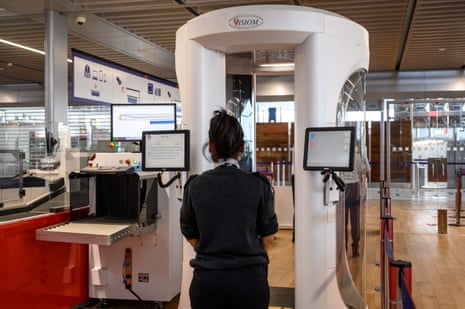Sydney airport has just begun using 3D body computed tomography scanners in its Qantas domestic terminal, T3. Though CT scanners have been widely used in international terminals in Australia for several years, and are in place in Melbourne’s T4 terminal and at Gladstone and Canberra airports, it is the first time many passengers have seen the technology at a domestic airport.
What are the scanners, and how do they work?
They are large tubes that passengers are asked to enter, before raising their arms while the machine rotates around them. They use nonionising millimetre-wave imaging to scan a person, looking for anything they may be carrying under their clothing. They are capable of detecting metallic and non-metallic items.
Airport security staff are presented with a generic cartoon outline of a person, with areas of interest highlighted in square boxes. Melbourne airport says no individual scans or personal information is stored or transmitted by the scanners.
CT scanners are also used for carry-on luggage.
Why are they being brought in?
In 2018 the then home affairs minister, Peter Dutton, announced that airports would be required to shift from using metal detectors, with budget funding earmarked for regional airports.
This came the year after two brothers plotted to blow up a passenger plane with a bomb hidden in a meat grinder.
“We’re worried about different devices going through the scanner that wouldn’t be picked up at the moment,” Dutton told the Melbourne radio station 3AW in 2018. “We’re worried about gels. We’re worried about noxious gases, all sorts of things which potentially don’t get picked up.”
Dutton said the new scanners would be rolled out “over the next couple of years” but it has taken four years for one checkpoint in one terminal of Australia’s busiest domestic airport to get the technology.
Guardian Australia understands the other checkpoints in T3 in Sydney will be upgraded with the same technology by the end of the year.
How much is it costing?
The Australian Airports Association estimates the cost of the upgrade is $2bn. In a pre-budget submission this year, it said the size, scope and scale of the upgrade, along with the pandemic’s effect on the airline industry, had made the project more complex for the 10 largest airports in Australia, and called for federal government funding to offset the cost.
Will they make going through airport security faster?
In theory, yes. CT scanning means passengers will no longer have to remove laptops, aerosols and other items from their carry-on luggage at security checkpoints. But they will still need to remove jackets and other outerwear.
Last week the ABC reporter Louise Milligan tweeted her experience of being required to remove a fitted jacket and said others had complained about security “heavy-handedness”.
Sydney airport declined to comment but the security contractor, Certis Security, told Guardian Australia the removal of coats and jackets was a requirement and referred inquiries to the regulator, the Cyber and Infrastructure Security Centre.
In practice, delays are still likely at airports given ongoing staffing shortages, so the scanners are not likely to shave off any time for quite a while.
Can I refuse to go through one?
Though exceptions are made for people who have medical or physical conditions that prevent them from going through body scanners, airports will refuse to let you enter the terminal if you do not comply.
